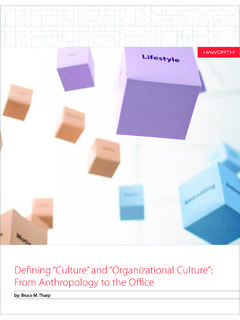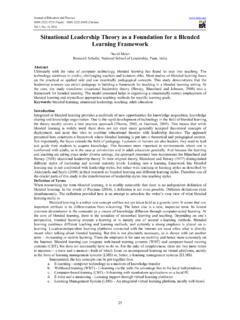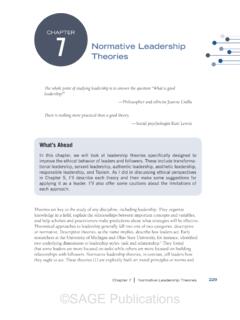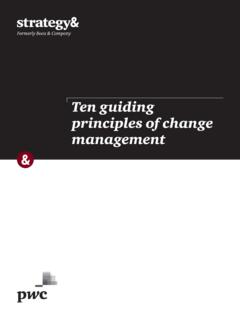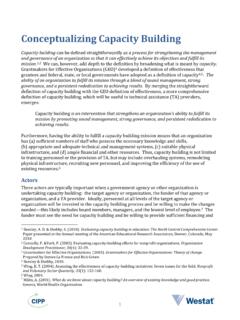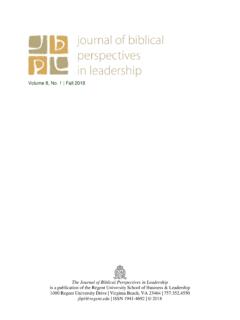Transcription of An Introduction to the Competing Values Framework
1 An Introduction to theCompeting Values Framework by: Kim Cameron, PhD2An Introduction to the Competing Values Framework / Competing Values FRAMEWORKThe Competing Values Framework was de-veloped initially from research conducted by University of Michigan faculty members on the major indicators of effective organizational per-formance. It has been found to be an extremely useful model for organizing and understanding a wide variety of organizational and individual phenomena, including theories of organiza-tional effectiveness, leadership competencies, organizational culture, organizational design, stages of life cycle development, organizational quality, leadership roles, financial strategy, information processing, and brain functioning. The robustness of the Framework is one of its greatest strengths.
2 In fact, the Framework has been identified as one of the 40 most impor-tant frameworks in the history of 20 years ago, the Framework emerged from research on the criteria that predict if an organization performs effectively. Those investigations were followed by studies of organizational culture, leadership roles, management skills, and information processing styles. From these empirical studies, two major dimensions consistently emerged. One dimen-sion differentiates an emphasis on flexibility, discretion, and dynamism from an emphasis on stability, order, and control. For example, some organizations and managers are viewed as effective if they are changing, adaptable, and transformational. Other organizations and man-agers are viewed as effective if they are stable, predictable, and consistent.
3 This continuum ranges from versatility and pliability on one end to steadiness and durability on the other second dimension differentiates an internal orientation with a focus on integration, collabo-ration, and unity from an external orientation with a focus on differentiation, competition, and rivalry. For example, some organizations and managers are viewed as effective if they have harmonious internal relationships and processes. Others are judged to be effective if they successfully compete against others and establish a market niche. This continuum ranges from cohesion and consonance on the one end to separation and independence on the the original research was conducted, these same dimensions have been repro-duced in a wide variety of research studies, from cognitive style to human development to philosophy.
4 The Framework , in other words, has proven to be very robust across a variety of phenomena, and it describes the core ap-proaches to thinking, behaving, and organizing associated with human these dimensions form four quad-rants, each representing a distinct set of organi-zational and individual factors. They identify, for example, the criteria of effectiveness that must be pursued by organizations, the leadership and managerial competencies that are most effective, the underlying culture of organiza-tions, and so on. What is notable about these four core Values is that they represent opposite or Competing assumptions. Each dimension highlights a core value that is opposite from the value on the other end of the , flexibility versus stability, internal versus external.
5 The dimensions, therefore, produce quadrants that are also contradictory or Competing on the diagonal. The upper left quadrant identifies Values that emphasize an internal, organic focus, whereas the lower right quadrant identifies Values that emphasize external, control focus. Similarly, the upper right quadrant identifies Values that emphasize external, organic focus whereas the lower left quadrant emphasizes internal, control Values . These Competing or opposite Values in each quadrant give rise the name for the model, the Competing Values the University of Michigan, the Competing Values Framework is used to organize an ap-proach to leadership and management devel-opment. Individual leadership competencies, for example, are developed and improved in the context of the organization s culture, its strategic competencies, financial strategies, pressing problems, and desired outcomes.
6 All of these factors are measured by instruments based on the Competing Values Framework , thus providing an integrated and consistent approach to individual and organizational development and improvement. An illustration of the Competing Values Framework provides an illustration of the key Values , leadership types, value drivers, approaches to change, and theories of development experiences and executive education programs often focus on competencies and capabilities that reside in each of the four different quadrants of the Framework . The specific leadership tools and techniques that receive emphasis with leader- ship groups are often determined by the orga-nization s own culture, aspirations for change, competencies of the senior leadership team, or the data feedback that individuals receive from various assessments.
7 For example, tools and techniques such as teamwork, collaboration, talent management, empowerment, or inter-personal relationships could be highlighted in the upper left opposite kinds of tools or techniques, such as competitiveness, fast response, decisive-ness, driving through barriers, or goal achieve-ment, could be highlighted in the lower right FOCUSED INTERNAL FLEXIBLEEXTERNAL FOCUSED INTERNAL FLEXIBLE DEVELOPMENT LONG-TERMCOLLABORATE(CLAN)Do things together EXTERNAL FOCUSED INTERNAL FLEXIBLE PERFORMANCE SHORT-TERM COMPETE(MARKET)Do things fast3An Introduction to the Competing Values Framework / Framework also suggests that tools and techniques focused on innovation, creativity, ar-ticulating future vision, transformation change, or entrepreneurship could be address in the upper right FOCUSED INTERNAL FLEXIBLE BREAKTHROUGHCREATE(ADHOCRACY)
8 Do things firstThe opposite kinds of tools or techniques, fo-cused on assessing and measuring, controlling processes, structuring, efficiency improvement, or quality enhancement, could be addressed in the lower left FOCUSED INTERNAL FLEXIBLE INCREMENTAL CONTROL(HIERARCHY)Do things rightEXTERNAL FOCUSED INTERNAL FLEXIBLE PERFORMANCE INCREMENTAL DEVELOPMENT BREAKTHROUGH SHORT-TERM LONG-TERM COLLABORATE(CLAN)Do things togetherCREATE(ADHOCRACY)Do things firstCOMPETE(MARKET)Do things fastCONTROL(HIERARCHY)Do things right4An Introduction to the Competing Values Framework / Competing Values Framework FOR CULTURE, leadership , EFFECTIVENESS, AND VALUE DRIVERSI ncremental ChangeExternal PositioningIndividuality FlexibilityStability ControlLong-term ChangeNew ChangeFast ChangeInternal MaintenanceCulture Type: CLANO rientation: COLLABORATEL eader Type: Facilitator Mentor Teambuilder Values Drivers: Commitment Communication DevelopmentTheory of Effectiveness: Human development and high commitment produce Type: ADHOCRACYO rientation: CREATEL eader Type: Innovator Entrepreneur VisionaryValue Drivers: Innovative outputs Transformation AgilityTheory of Effectiveness.
9 Innovativeness, vision and constant change produce Type: MARKETO rientation: COMPETEL eader Type: Hard-driver Competitor ProducerValue Drivers: Market Share Goal achievement ProfitabilityTheory of Effectiveness: Aggressively Competing and customer focus produce effectiveness. Culture Type: HIERARCHYO rientation: CONTROLL eader Type: Coordinator Monitor OrganizerValue Drivers: Efficiency Timeliness Consistency & UniformityTheory of Effectiveness: Control and efficiency with capable processes produce effectiveness.
